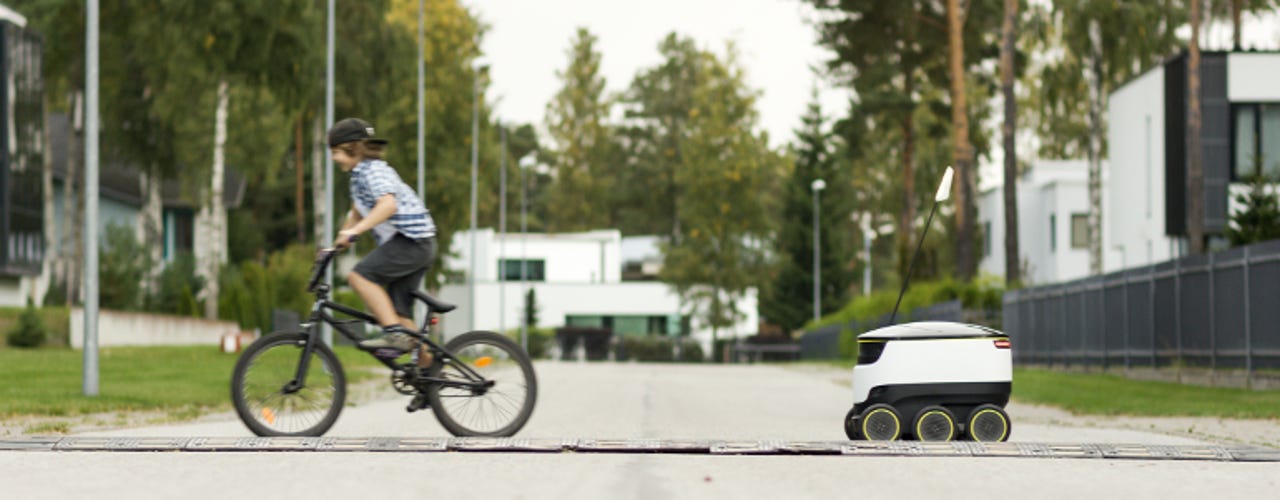Move over drones: Here come Skype co-founders' self-driving delivery robots


Starship's delivery robots, which resemble stylish cooler boxes on six wheels, can autonomously roam pavements at a brisk walking speed of 4mph.
Delivery drones and the legislative and security issues surrounding them have caused plenty of debate recently.
But while several companies, notably Amazon and Google, are focused on cracking parcel delivery by air, it could be on the streets where robotic local deliveries will first take off -- and as soon as this year.
"We realised it's possible to do deliveries using a small land-based robot and it would be much simpler and safer than drones, for instance," Starship Technologies CEO Ahti Heinla told ZDNet.
Starship is the Estonian venture of two former Skype co-founders, Heinla and Janus Friis, who revealed the prototype of their self-driving delivery robot in November.
The robots, which resemble stylish cooler boxes on six wheels, can autonomously roam pavements at a brisk walking speed of 4mph and deliver the equivalent of two full shopping bags of about 20lb (9.1kg) in less than 30 minutes.
Starship Technologies COO Allan Martinson and CEO Ahti Heinla: Robots can be 10 to 15 times cheaper than human-powered delivery.
Starship's claim is to make local deliveries efficient, safe, low emission, and, crucially to the industry, as cheap as possible.
"[Local delivery] is a perfect example of an industry which can be disrupted using robotics," Starship Technologies COO Allan Martinson says. "Robotics is already on a level where we can build these robots and technologically it will be cheap enough to do deliveries for the last three to four miles for less than £1 ($1.45). It's 10 to 15 times cheaper than human-powered delivery."
The battery-operated robots are built for short, local deliveries, such as groceries in residential neighbourhoods. Starship's plan is to house the robots outside retail centres in 'hubs' built from shipping containers.
When an order is received, the robot sets off towards its destination. The recipient can follow its location through a mobile app, which is also used to unlock the cargo on arrival.
Heinla describes Starship's approach as a "fast track to self-driving cars". A small delivery robot slowly driving on a pavement only needs to see 5m to 10m around itself which, according to Heinla, can be done with a lower-cost technology than that required by self-driving cars.
Furthermore, while Starship says the robots move autonomously 99 percent of the time, they are overseen by human operators to ensure safety. The robots use built-in GPS, several cameras, and computer vision as well as proprietary mapping and obstacle-avoidance software to navigate the route. When faced with a difficult situation, the robot can use mobile internet to alert the operator, who then remotely takes control.
Starship's proposition will be put to test early this year when the startup's first pilot trials are scheduled to take place in parts of Greenwich in London. Heinla admits the robots are not completely ready for scaling yet, but lessons from the first pilots will be taken to expand testing elsewhere in Europe and the US.
Starship aims to set up the company's first full-time delivery service during the second half of 2016 and start commercial expansion in 2017.
The battery-operated robots are built for short, local deliveries, such as groceries in residential neighbourhoods.
But while Starship claims to offer the most advanced option currently available, and its team has grown to over 30 members, it is not the only company to have noticed the opportunities in ground deliveries.
Since April 2015, Lithuanian startup Sidewalk has been developing its own four-wheeled delivery robot based on a similar concept of stationing semi-autonomous robots outside retail centres.
It remains early days for the company but it has already built two prototypes, one in partnership with the logistics giant DHL, and is in discussions to test its robot in Vilnius next year.
Sidewalk CTO and founder Mangirdas Skripka sees competition as a good thing, as it helps to drive legislation in a positive direction for self-driving vehicles.
Both Skripka and Martinson note that delivery robots currently operate in something of a legislative grey area as, unlike self-driving cars and drones, they move slowly, do not drive on roads, or occupy airspace.
"Many countries are discussing banning [drones] or allowing them only with certain limitations, but there is not much discussion about sidewalks and movement on sidewalks," Skripka says.
While drones have the potential to offer more direct deliveries because ground robots cannot operate on busy sidewalks or access apartment buildings, Heinla sees their capacity to carry larger cargo, with greater reliability and safety, as benefits over drones.
Furthermore, the first commercial applications of delivery robots could be seen as early as this year, while there is currently no timeline for the likes of Amazon's drone delivery project Prime Air.
Heinla adds that where airborne drones have caused negative reactions from people worried about privacy issues, most people don't have any kind of emotional response to delivery robots on pavements. This finding is based on evidence from test-driving the Starship robot for 150km in five cities: Boston, Dublin, London, New York, and San Francisco.
"We have met around 7,000 people in the process and not a single person has voiced any negative emotion. Maybe the most surprising thing has been that 90 percent haven't expressed any emotion at all," says Martinson.
These attitudes could change if sidewalks were crawling with delivery robots. But one thing is for sure: robotics, both on the ground and in the air, represents the future of local deliveries.
Read more about robotic delivery
- Who will fly all those Amazon delivery drones?
- Game of drones: How airborne delivery tests are starting to take off
- MPS decide drones invade Australian privacy
- Robot-maker Savioke announces partnership with major hotel chain
- How a grocery delivery service became a red hot robotics company
- Eco-friendly self-driving delivery bots reach UK, US sidewalks